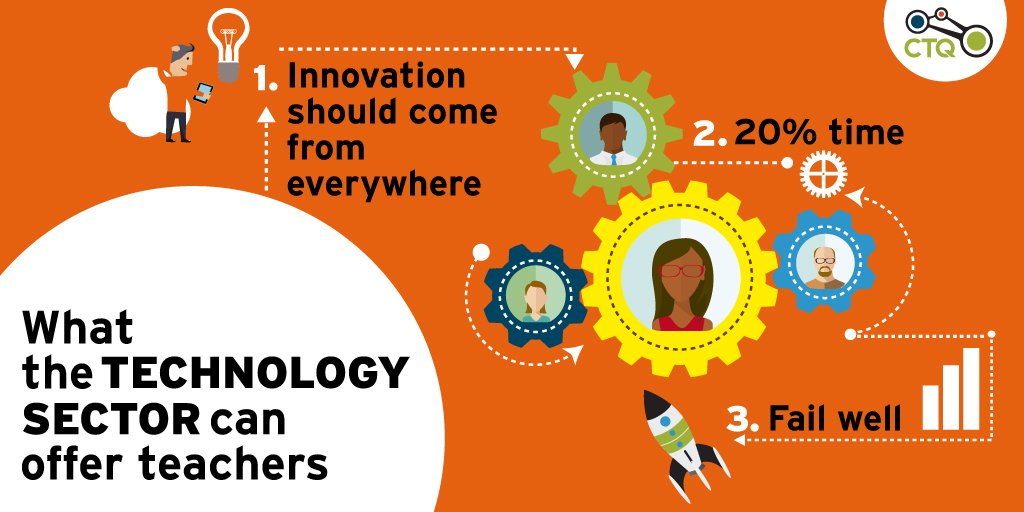Sure, technology can transform teaching and learning. But the sector’s most significant legacy for American schools might have little to do with apps for students—and everything to do with revolutionary organizational designs.
In recent years, school reformers, philanthropists, and venture capital investors have placed big bets on blended learning, and edtech professionals have responded with vigor. But as education historian Larry Cuban has noted, the innovative instruction envisioned by edtech advocates remains the exception to the rule—in large part because of the lack of time for teachers to “learn, experiment, and overhaul their practices in collaboration with each other."
Operating within archaic organizational structures, very few of our nation’s teachers have opportunities to incubate and execute ideas prompted by their deep knowledge of students, families, and communities. This includes ideas about how best to integrate technology. What if—along with adopting new tools for personalized, on-demand learning—our education system learned a thing or two from the technology sector about how to run a productive 21st-century workplace?
Consider, for example, Google’s 9 principles of innovation for every organization, to which many attribute the company’s dominance in the market. I’ll hone in on just three of the nine as I indicate how the technology sector can help schools maximize teacher expertise:

1. Innovation should come from everywhere
At Google, it is “the job of everyone to innovate, from top to bottom.” That’s why technology companies often sponsor hackathons to invent new products and solve thorny operational problems. (Facebook’s ubiquitous “Like” button grew out of a hackathon.) Contrast this with K-12 school environments, where teachers operate in silos, teaching their respective classes and devoting one or at best two hours a week to collaborative planning—with little or any time for innovation.
But as a recent Harvard Business Review post enjoined, hackathons are not just for coders. At the Center for Teaching Quality (CTQ), our TeacherSolutions model, like the one we used with Brevard County educators, stokes creativity and prototypes promising ideas quickly.
Edtech innovators have created terrific apps like Vroom, designed to provide parents and educators with just-in-time information on how to best support “brain-building moments” for young children. How could the same technology be put to use to help school administrators support innovation “from everywhere”? For example, an app might guide practitioners through “hacking” an educational problem, documenting and marketing teachers’ innovative practices, or better yet, figuring out how to create 20% time for a proportion of a school’s teachers.
2. 20% Time
Google offers its employees approximately one day a week to “act on their innovative spirit,” advancing ideas like Street View from a bike. (It allows users to view locales not accessible by car.) I have to wonder, what could even a small proportion of our nation’s expert teachers create if schools granted them 20% time to innovate?
It’s not impossible. Teachers in Singapore teach only about half of the amount of time that their American counterparts spend in the classroom each week. The remainder of Singaporean teachers’ work time is devoted to planning and collaboration—and some are also granted “Google time” for innovation. And here in the U.S., the Generation Schools Network has finagled substantially more collaborative planning time for teachers than most of their colleagues have.
What gets in the way of most American teachers’ potential to incubate and execute ideas about better serving their students? For one thing, few principals have been prepared to run schools (and schedule teaching and learning) in ways different from what they experienced as students. Meanwhile, our nation’s schools have almost as many administrators as teachers. In many top-performing nations, administrators also teach part of the day or the week, which occurs only rarely in American schools.
We can organize time and people differently. And I suspect the edtech sector—drawing on how technology companies organize people and make the time and space for innovation—can create an array of tools to help American policy leaders rethink time in schools so more teachers can lead.
3. Fail Well
At Google, failure can be “badge of honor.” The company’s digital graveyard includes innovations like Buzz, Google Wave, and Google Dictionary, which have led to later successes.
European university researchers Oliver Baumann and Nils Stieglitz suggest that “to get more breakthroughs, the best approach is to focus on increasing the variety of ideas that are generated.” They note that some companies are experimenting with rewarding “brilliant failures that provide some sort of insights, even if they turn out not to work.”
The attitude in most schools couldn’t be more different. As education policy expert Linda Darling-Hammond has noted, our nation’s “test-and-punish approach” to accountability has tamped down much-needed innovation.
How can edtech encourage teachers to fail well, taking risks that could yield valuable lessons to benefit students? More than anything else, schools need sound models for how to help teachers “fail forward”—perhaps including the technology sector’s innovation tournaments and the clever use of non-financial incentives.
Don’t get me wrong. Edtech can create extraordinarily valuable and effective tools for use directly with students. And there are some isolated “bright spots” out there where American teachers do have access to extra time in which to personalize student learning—like at some of the Breakthrough schools funded through the Next Generation Learning Challenges.
But many, many more of today’s schools urgently need new organizational designs that unleash innovation, encourage the rapid spread of expertise, and make time for teachers to thoughtfully integrate new technologies.
I bet there may be an app or two for that?


